TP-Link Archer C55 Manual

User Guide
AC1200 Wireless Dual Band Router
Archer C55
REV1.0.0 1910012259
Contents
About This Guide . . . . . . . . . . . . . . . . . . . . . . . . . . . . . . . . . . . . . . . . . . . . . . . . . . . . . 1
Chapter 1. Get to Know About Your Router . . . . . . . . . . . . . . . . . . . . . . . . . . . 2
1. 1. Product Overview . . . . . . . . . . . . . . . . . . . . . . . . . . . . . . . . . . . . . . . . . . . . . . . . . . . . . . . . . . . .3 1. 2. Panel Layout . . . . . . . . . . . . . . . . . . . . . . . . . . . . . . . . . . . . . . . . . . . . . . . . . . . . . . . . . . . . . . . . .3 1. 2. 1.Top View. . . . . . . . . . . . . . . . . . . . . . . . . . . . . . . . . . . . . . . . . . . . . . . . . . . . . . . . . . . . . . .3 1. 2. 2.Back Panel. . . . . . . . . . . . . . . . . . . . . . . . . . . . . . . . . . . . . . . . . . . . . . . . . . . . . . . . . . . . .4
Chapter 2. Connect the Hardware . . . . . . . . . . . . . . . . . . . . . . . . . . . . . . . . . . . 6
2. 1. Position Your Router. . . . . . . . . . . . . . . . . . . . . . . . . . . . . . . . . . . . . . . . . . . . . . . . . . . . . . . . . .7
2. 2. Connect Your Router . . . . . . . . . . . . . . . . . . . . . . . . . . . . . . . . . . . . . . . . . . . . . . . . . . . . . . . . .7
Chapter 3. Log In . . . . . . . . . . . . . . . . . . . . . . . . . . . . . . . . . . . . . . . . . . . . . . . . . . . 10
Chapter 4. Configure the Router . . . . . . . . . . . . . . . . . . . . . . . . . . . . . . . . . . . . 12
4. 1. Status. . . . . . . . . . . . . . . . . . . . . . . . . . . . . . . . . . . . . . . . . . . . . . . . . . . . . . . . . . . . . . . . . . . . . . 13 4. 2. Quick Setup. . . . . . . . . . . . . . . . . . . . . . . . . . . . . . . . . . . . . . . . . . . . . . . . . . . . . . . . . . . . . . . . 14 4. 3. Operation Mode. . . . . . . . . . . . . . . . . . . . . . . . . . . . . . . . . . . . . . . . . . . . . . . . . . . . . . . . . . . . 15 4. 3. 1.Wireless Router Mode . . . . . . . . . . . . . . . . . . . . . . . . . . . . . . . . . . . . . . . . . . . . . . . 15 4. 3. 2.Access Point Mode . . . . . . . . . . . . . . . . . . . . . . . . . . . . . . . . . . . . . . . . . . . . . . . . . . 15
4. 4. Network. . . . . . . . . . . . . . . . . . . . . . . . . . . . . . . . . . . . . . . . . . . . . . . . . . . . . . . . . . . . . . . . . . . . 16 4. 4. 1. WAN . . . . . . . . . . . . . . . . . . . . . . . . . . . . . . . . . . . . . . . . . . . . . . . . . . . . . . . . . . . . . . . 16 4. 4. 2. LAN . . . . . . . . . . . . . . . . . . . . . . . . . . . . . . . . . . . . . . . . . . . . . . . . . . . . . . . . . . . . . . . 23 4. 4. 3. IPTV . . . . . . . . . . . . . . . . . . . . . . . . . . . . . . . . . . . . . . . . . . . . . . . . . . . . . . . . . . . . . . . 23 4. 4. 4.MAC Clone . . . . . . . . . . . . . . . . . . . . . . . . . . . . . . . . . . . . . . . . . . . . . . . . . . . . . . . . . . 24
4. 5. Wireless (2.4GHz or 5GHz). . . . . . . . . . . . . . . . . . . . . . . . . . . . . . . . . . . . . . . . . . . . . . . . . . 25 4. 5. 1.Wireless Settings . . . . . . . . . . . . . . . . . . . . . . . . . . . . . . . . . . . . . . . . . . . . . . . . . . . . 25 4. 5. 2. WPS . . . . . . . . . . . . . . . . . . . . . . . . . . . . . . . . . . . . . . . . . . . . . . . . . . . . . . . . . . . . . . . 26 4. 5. 3.Wireless Security . . . . . . . . . . . . . . . . . . . . . . . . . . . . . . . . . . . . . . . . . . . . . . . . . . . . 28 4. 5. 4.Wireless Schedule . . . . . . . . . . . . . . . . . . . . . . . . . . . . . . . . . . . . . . . . . . . . . . . . . . . 30 4. 5. 5.Wireless MAC Filtering . . . . . . . . . . . . . . . . . . . . . . . . . . . . . . . . . . . . . . . . . . . . . . . 31 4. 5. 6.Wireless Advanced . . . . . . . . . . . . . . . . . . . . . . . . . . . . . . . . . . . . . . . . . . . . . . . . . . 32 4. 5. 7.Wireless Statistics . . . . . . . . . . . . . . . . . . . . . . . . . . . . . . . . . . . . . . . . . . . . . . . . . . . 34
4. 6. Guest Network . . . . . . . . . . . . . . . . . . . . . . . . . . . . . . . . . . . . . . . . . . . . . . . . . . . . . . . . . . . . . 34 4. 7. DHCP . . . . . . . . . . . . . . . . . . . . . . . . . . . . . . . . . . . . . . . . . . . . . . . . . . . . . . . . . . . . . . . . . . . . . . 35
4. 7. 1.DHCP Settings. . . . . . . . . . . . . . . . . . . . . . . . . . . . . . . . . . . . . . . . . . . . . . . . . . . . . . . 36 4. 7. 2.DHCP Client List . . . . . . . . . . . . . . . . . . . . . . . . . . . . . . . . . . . . . . . . . . . . . . . . . . . . . 37 4. 7. 3.Address Reservation. . . . . . . . . . . . . . . . . . . . . . . . . . . . . . . . . . . . . . . . . . . . . . . . . 37
4. 8. Forwarding. . . . . . . . . . . . . . . . . . . . . . . . . . . . . . . . . . . . . . . . . . . . . . . . . . . . . . . . . . . . . . . . . 38 4. 8. 1.Virtual Server . . . . . . . . . . . . . . . . . . . . . . . . . . . . . . . . . . . . . . . . . . . . . . . . . . . . . . . . 38 4. 8. 2.Port Triggering. . . . . . . . . . . . . . . . . . . . . . . . . . . . . . . . . . . . . . . . . . . . . . . . . . . . . . . 39 4. 8. 3. DMZ . . . . . . . . . . . . . . . . . . . . . . . . . . . . . . . . . . . . . . . . . . . . . . . . . . . . . . . . . . . . . . . 40 4. 8. 4. UPnP . . . . . . . . . . . . . . . . . . . . . . . . . . . . . . . . . . . . . . . . . . . . . . . . . . . . . . . . . . . . . . . 41
4. 9. Security. . . . . . . . . . . . . . . . . . . . . . . . . . . . . . . . . . . . . . . . . . . . . . . . . . . . . . . . . . . . . . . . . . . . 42 4. 9. 1.Basic Security . . . . . . . . . . . . . . . . . . . . . . . . . . . . . . . . . . . . . . . . . . . . . . . . . . . . . . . 42 4. 9. 2.Advanced Security . . . . . . . . . . . . . . . . . . . . . . . . . . . . . . . . . . . . . . . . . . . . . . . . . . 44 4. 9. 3.Local Management . . . . . . . . . . . . . . . . . . . . . . . . . . . . . . . . . . . . . . . . . . . . . . . . . . 45 4. 9. 4.Remote Management . . . . . . . . . . . . . . . . . . . . . . . . . . . . . . . . . . . . . . . . . . . . . . . . 46
4. 10. Parental Controls. . . . . . . . . . . . . . . . . . . . . . . . . . . . . . . . . . . . . . . . . . . . . . . . . . . . . . . . . . . 47 4. 11. Access Control. . . . . . . . . . . . . . . . . . . . . . . . . . . . . . . . . . . . . . . . . . . . . . . . . . . . . . . . . . . . . 47 4. 12. Advanced Routing. . . . . . . . . . . . . . . . . . . . . . . . . . . . . . . . . . . . . . . . . . . . . . . . . . . . . . . . . . 50 4. 12. 1.Static Route List. . . . . . . . . . . . . . . . . . . . . . . . . . . . . . . . . . . . . . . . . . . . . . . . . . . . 50 4. 12. 2.System Routing Table . . . . . . . . . . . . . . . . . . . . . . . . . . . . . . . . . . . . . . . . . . . . . . 51
4. 13. Bandwidth Control . . . . . . . . . . . . . . . . . . . . . . . . . . . . . . . . . . . . . . . . . . . . . . . . . . . . . . . . . 52 4. 13. 1.Control Settings. . . . . . . . . . . . . . . . . . . . . . . . . . . . . . . . . . . . . . . . . . . . . . . . . . . . 52 4. 13. 2.Rule List. . . . . . . . . . . . . . . . . . . . . . . . . . . . . . . . . . . . . . . . . . . . . . . . . . . . . . . . . . . . 52
4. 14. IP&MAC Binding. . . . . . . . . . . . . . . . . . . . . . . . . . . . . . . . . . . . . . . . . . . . . . . . . . . . . . . . . . . . 53 4. 14. 1.Binding Settings. . . . . . . . . . . . . . . . . . . . . . . . . . . . . . . . . . . . . . . . . . . . . . . . . . . . 54 4. 14. 2.ARP List . . . . . . . . . . . . . . . . . . . . . . . . . . . . . . . . . . . . . . . . . . . . . . . . . . . . . . . . . . . . 54
4. 15. Dynamic DNS . . . . . . . . . . . . . . . . . . . . . . . . . . . . . . . . . . . . . . . . . . . . . . . . . . . . . . . . . . . . . . 55 4. 16. IPv6. . . . . . . . . . . . . . . . . . . . . . . . . . . . . . . . . . . . . . . . . . . . . . . . . . . . . . . . . . . . . . . . . . . . . . . . 58 4. 16. 1.IPv6 Status. . . . . . . . . . . . . . . . . . . . . . . . . . . . . . . . . . . . . . . . . . . . . . . . . . . . . . . . . 58 4. 16. 2.IPv6 WAN . . . . . . . . . . . . . . . . . . . . . . . . . . . . . . . . . . . . . . . . . . . . . . . . . . . . . . . . . . 58 4. 16. 3.IPv6 LAN . . . . . . . . . . . . . . . . . . . . . . . . . . . . . . . . . . . . . . . . . . . . . . . . . . . . . . . . . . . 62
4. 17. System Tools. . . . . . . . . . . . . . . . . . . . . . . . . . . . . . . . . . . . . . . . . . . . . . . . . . . . . . . . . . . . . . . 63 4. 17. 1.Time Settings . . . . . . . . . . . . . . . . . . . . . . . . . . . . . . . . . . . . . . . . . . . . . . . . . . . . . . 63 4. 17. 2.LED Control . . . . . . . . . . . . . . . . . . . . . . . . . . . . . . . . . . . . . . . . . . . . . . . . . . . . . . . . 64 4. 17. 3.Feedback . . . . . . . . . . . . . . . . . . . . . . . . . . . . . . . . . . . . . . . . . . . . . . . . . . . . . . . . . . 64 4. 17. 4.Diagnostic . . . . . . . . . . . . . . . . . . . . . . . . . . . . . . . . . . . . . . . . . . . . . . . . . . . . . . . . . 65 4. 17. 5.Firmware Upgrade. . . . . . . . . . . . . . . . . . . . . . . . . . . . . . . . . . . . . . . . . . . . . . . . . . 66 4. 17. 6.Factory Defaults. . . . . . . . . . . . . . . . . . . . . . . . . . . . . . . . . . . . . . . . . . . . . . . . . . . . 67 4. 17. 7.Backup & Restore . . . . . . . . . . . . . . . . . . . . . . . . . . . . . . . . . . . . . . . . . . . . . . . . . . 67 4. 17. 8.Reboot . . . . . . . . . . . . . . . . . . . . . . . . . . . . . . . . . . . . . . . . . . . . . . . . . . . . . . . . . . . . . 68 4. 17. 9.Password . . . . . . . . . . . . . . . . . . . . . . . . . . . . . . . . . . . . . . . . . . . . . . . . . . . . . . . . . . 69
4. 17. 10.Language . . . . . . . . . . . . . . . . . . . . . . . . . . . . . . . . . . . . . . . . . . . . . . . . . . . . . . . . . 69 4. 17. 11.System Log . . . . . . . . . . . . . . . . . . . . . . . . . . . . . . . . . . . . . . . . . . . . . . . . . . . . . . . 70 4. 17. 12.Statistics . . . . . . . . . . . . . . . . . . . . . . . . . . . . . . . . . . . . . . . . . . . . . . . . . . . . . . . . . 70
4. 18. Log Out . . . . . . . . . . . . . . . . . . . . . . . . . . . . . . . . . . . . . . . . . . . . . . . . . . . . . . . . . . . . . . . . . . . . 71
FAQ . . . . . . . . . . . . . . . . . . . . . . . . . . . . . . . . . . . . . . . . . . . . . . . . . . . . . . . . . . . . . . . . . 72

About This Guide
This guide is a complement to Quick Installation Guide. The Quick Installation Guide provides instructions for quick internet setup, while this guide contains details of each function and demonstrates how to configure them.
When using this guide, please notice that features of the router may vary slightly depending on the model and software version you have, and on your location, language, and internet service provider. All screenshots, images, parameters and descriptions documented in this guide are used for demonstration only.
Conventions
In this guide the following conventions are used:
Convention |
Description |
|
Underlined |
Underlined words or phrases are hyperlinks. You can click to redirect to a website or a |
|
specific section. |
||
|
||
Teal |
Contents to be emphasized and texts on the web page are in teal, including the menus, |
|
items, buttons and so on. |
||
|
The menu structures to show the path to load the corresponding page. For example,
>Advanced > Wireless > MAC Filtering means the MAC Filtering function page is under the Wireless menu that is located in the Advanced tab.
|
|
|
Note: |
Ignoring this type of note might result in a malfunction or damage to the device. |
|
|
|
|
|||
|
|
|
|
|
|
|
|
|
|
Tips: |
Indicates important information that helps you make better use of your device. |
|
|
|
|
||
|
|
|
|
||
More Info
The latest software, management app and utility are available from the Download Center at www.tp-link.com/support.
The Quick Installation Guide can be found where you find this guide or inside the package of the router.
Specifications can be found on the product page at http://www.tp-link.com.
A Technical Support Forum is provided for you to discuss our products at http://forum.tp-link.com.
Our Technical Support contact information can be found at the Contact Technical Support page at www.tp-link.com/support.
1

Chapter 1
Get to Know About Your Router
This chapter introduces what the router can do and shows its appearance. It contains the following sections:
•Product Overview
•Panel Layout
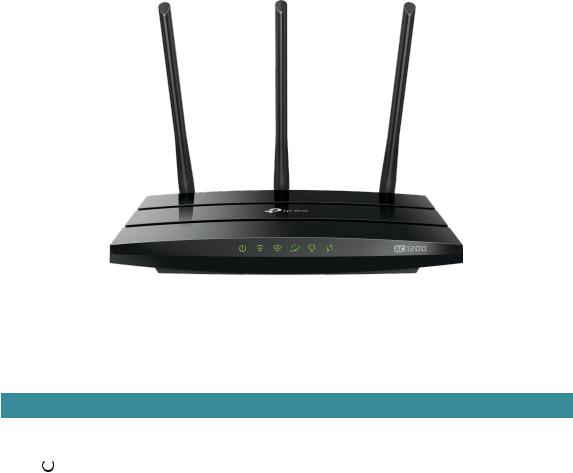
Chapter 1 |
Get to Know About Your Router |
1. 1. Product Overview
The TP-Link router is designed to fully meet the need of Small Office/Home Office (SOHO) networks and users demanding higher networking performance. The powerful antennas ensure continuous Wi-Fi signal to all your devices while boosting widespread coverage throughout your home, and the built-in Ethernet ports supply high-speed connection to your wired devices.
Moreover, it is simple and convenient to set up and use the TP-Link router due to its intuitive web interface and the powerful Tether app.
1. 2. Panel Layout
1. 2. 1. Top View
The router’s LEDs (view from left to right) are located on the front panel. You can check the router’s working status by following the LED Explanation table.
LED Explanation
|
Name |
Status |
Indication |
|
|
On |
The system has started up successfully. |
|
(Power) |
Flashing |
The system is starting up or firmware is being upgraded. Do not |
|
|||
|
disconnect or power off your router. |
||
|
|
Off |
Power is off. |
3
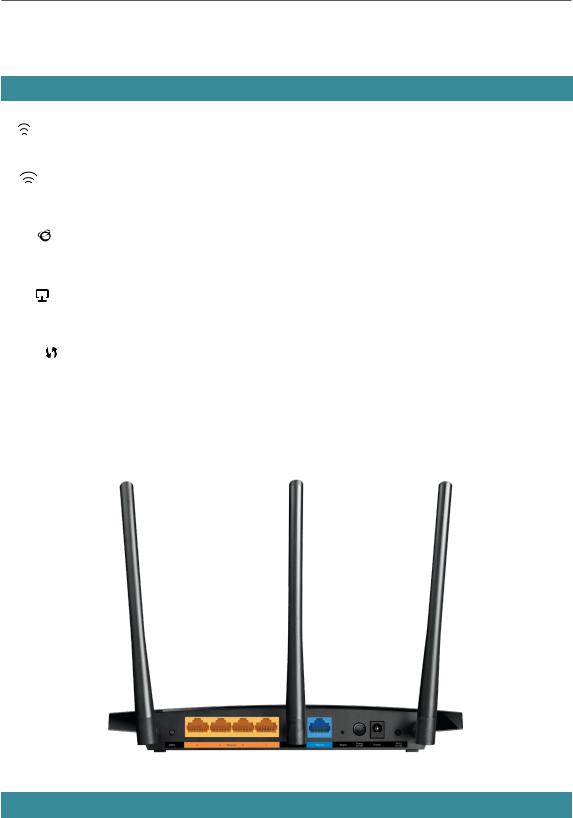
Chapter 1 Get to Know About Your Router
LED Explanation
Name |
Status |
Indication |
|
(2.4GHz Wireless) |
On |
The 2.4GHz wireless band is enabled. |
|
Off |
The 2.4GHz wireless band is disabled. |
||
|
|||
(5GHz Wireless) |
On |
The 5GHz wireless band is enabled. |
|
Off |
The 5GHz wireless band is disabled. |
||
|
|||
|
Green On |
Internet service is available. |
|
(Internet) |
Orange On |
The router’s Internet port is connected, but the internet is not available. |
|
|
Off |
The router’s Internet port is not connected. |
|
(Ethernet) |
On |
At least one Ethernet ports is connected to a powered-on device. |
|
Off |
No Ethernet port is connected to a powered-on device. |
||
|
|||
|
On/Off |
This light remains on for 5 minutes when a WPS connection is |
|
(WPS) |
established, and then turns off. |
||
|
|||
|
Flashing |
WPS connection is in progress. This may take up to 2 minutes. |
1. 2. 2. Back Panel
The following parts (view from left to right) are located on the rear panel.
Item |
Description |
WPS Button |
Press this button, and immediately press the WPS button on your device. The WPS |
LED of the router should change from flashing to solid on, indicating successful WPS |
|
|
connection. |
Ethernet Ports (1/2/3/4) |
For connecting your PCs or other wired network devices to the router. |
4

Chapter 1 |
Get to Know About Your Router |
|
|
|
|
Item |
Description |
|
Internet Port |
For connecting to a DSL/Cable modem, or an Ethernet port. |
|
Reset Button |
Press and hold this button for about 2 seconds to reset the router to its factory |
|
default settings. |
||
|
||
Power On/Off Button |
Press this button to power on or off the router. |
|
Power Port |
For connecting the router to a power socket via the provided power adapter. |
|
Wi-Fi On/Off Button |
Press and hold this button for about 2 seconds to turn on or off the wireless function |
|
of your router. |
||
|
||
Antennas |
Used for wireless operation and data transmitting. Upright them for the best Wi-Fi |
|
performance. |
||
|
5

Chapter 2
Connect the Hardware
This chapter contains the following sections:
•Position Your Router
•Connect Your Router

Chapter 2 |
Connect the Hardware |
2. 1. Position Your Router
•The product should not be located in a place where it will be exposed to moisture or excessive heat.
•Place the router in a location where it can be connected to multiple devices as well as to a power source.
•Make sure the cables and power cord are safely placed out of the way so they do not create a tripping hazard.
•The router can be placed on a shelf or desktop.
•Keep the router away from strong devices with strong electromagnetic interference, such as Bluetooth devices, cordless phones and microwaves.
2. 2. Connect Your Router
This router enables multiple users to share internet connection via ADSL/Cable Modem. 1. Follow the steps below to connect your router.
If your internet connection is through an Ethernet cable directly from the wall instead of through a DSL / Cable / Satellite modem, connect the Ethernet cable to the router’s Internet port, and then follow steps 4 and 5 to complete the hardware connection.
Power adapter
4
|
Internet |
|
1 |
|
2 |
Power adapter |
Modem |
|
3 |
1 ) |
Turn off the modem, and remove the backup battery if it has one. |
2 ) |
Connect the modem to the router’s Internet port with an Ethernet cable. |
3 ) |
Turn on the modem, and then wait about 2 minutes for it to restart. |
7

Chapter 2 |
|
|
Connect the Hardware |
|
4 ) |
Connect the power adapter to the router and turn on the router. |
|||
5 ) |
Verify that the following LEDs are on and solid to confirm the hardware is |
|||
|
connected correctly. |
|
|
|
|
Power |
2.4GHz |
5GHz |
Internet |
|
On |
On |
On |
On |
 Note:
Note:
If the 2.4GHz and 5GHz LEDs are off, press and hold the Wi-Fi On/Off button on the rear panel for about 2 seconds to turn them on.
2. Connect your computer to the router.
• Method 1: Wired
Turn off the Wi-Fi on your computer and connect the devices as shown below.
Ethernet cable
•Method 2: Wirelessly
1) Find the SSID (Network Name) and Wireless Password printed on the label at the bottom of the router.
2) Click the network icon of your computer or go to Wi-Fi Settings of your smart device, and then select the SSID to join the network.
|
|
|
|
Computer |
|
|
|
|
|
|
|
Smart Device |
||
|
|
|
|
Connections are available |
|
|
|
< Settings |
Wi-Fi |
|||||
|
|
|
|
|
|
|
|
|
|
|
||||
|
|
|
|
|
|
|
|
|
|
|
||||
|
|
|
|
|
|
|
|
|
|
|
|
|
|
|
|
|
|
|
|
|
|
|
|
|
|
Wi-Fi |
|
|
|
Wireless Network Connection |
|
|
|
|
|
|
|
|
|
|||||
|
|
|
|
|
|
|
|
|
|
|
CHOOSE A NETWORK... |
|||
TP-Link_XXXX |
|
|
|
|
|
|||||||||
|
|
|
|
|||||||||||
|
|
|
|
|
|
|
|
|
|
|||||
TP-Link_XXXX_5G |
|
|
|
|
|
|
TP-Link_XXXX |
|
|
|||||
|
|
|
|
|
|
|
|
|||||||
|
|
|
Connect automatically |
Connect |
|
|
|
|
|
|||||
|
|
|
|
|
|
|
||||||||
|
|
|
|
|
|
TP-Link_XXXX_5G |
|
|
||||||
|
|
|
|
|
|
|
||||||||
|
|
|
|
|
|
|
||||||||
Other...
• Method 3: Use the WPS button
Wireless devices that support WPS, including Android phones, tablets and most USB network cards, can be connected to your router through this method ( not supported by iOS devices).
 Note:
Note:
The WPS function cannot be configured if the wireless function of the router is disabled. Also, the WPS function will be disabled if your wireless encryption is WEP. Please make sure the wireless function is enabled and is configured with the appropriate encryption before configuring the WPS.
8
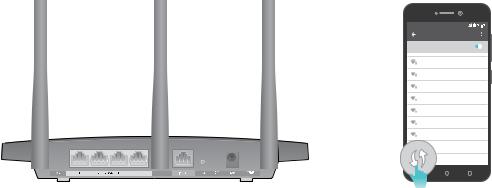
Chapter 2 |
Connect the Hardware |
|
1 ) |
Tab the WPS icon on the device’s screen. Here we take an Android phone as an |
|
|
example. |
|
2 ) |
Immediately press the WPS button on your router. |
|
Close to
WLAN
On
TP-LINK
YSL
David
Hotdog
Ts_5G
Sunny
Test
9

Chapter 3
Log In
This chapter introduces how to log in to the web management page of router.
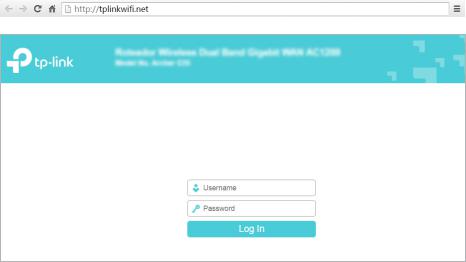
Chapter 3 |
Log In |
With the web management page, it is easy to configure and manage the router. The web management page can be used on any Windows, Macintosh or UNIX OS with a Web browser, such as Microsoft the Internet Explorer, Mozilla Firefox or Apple Safari.
Follow the steps below to log in to your router.
1.Set up the TCP/IP Protocol in Obtain an IP address automatically mode on your computer.
2.Launch a web browser, and visit http://tplinkwifi.net or http://192.168.0.1. Use admin for both username and password to log in.
 Note:
Note:
If the login window does not appear, please refer to the FAQ section.
3.For security purposes, go to System Tools > Password and create a new username and password for future logins.
11

Chapter 4
Configure the Router
This chapter presents how to configure the various features of the router. It contains the following sections:
• Status
• Quick Setup
• Operation Mode
• Network
• Wireless (2.4GHz or 5GHz)
• Guest Network
• DHCP
• Forwarding
• Security

Chapter 4 |
Configure the Router |
4. 1. Status
1.Visit http://tplinkwifi.net, and log in with the username and password you set for the router.
2.Go to Status. You can view the current status information of the router.
13
Chapter 4 |
Configure the Router |
•Firmware Version - The version information of the router’s firmware.
•Hardware Version - The version information of the router’s hardware.
•LAN - This field displays the current settings of the LAN, and you can configure them on the Network > LAN page.
•MAC address - The physical address of the router.
•IP address - The LAN IP address of the router.
•Subnet Mask - The subnet mask associated with the LAN IP address.
•Wireless 2.4GHz/5GHz - This field displays the basic information or status of the wireless function, and you can configure them on the Wireless > Basic Settings page.
•Operation Mode - The current wireless working mode in use.
•Wireless Radio - Indicates whether the wireless radio feature of the Router is enabled or disabled.
•Name(SSID) - The SSID of the Router.
•Mode - The current wireless mode which the router works on.
•Channel - The current wireless channel in use.
•Channel Width - The current wireless channel width in use.
•MAC Address - The physical address of the router.
•WDS Status - The status of the WDS connection is displayed.
•WAN - This field displays the current settings of the WAN, and you can configure them on the Network > WAN page.
•MAC Address - The physical address of the WAN port.
•IP Address - The current WAN (Internet) IP Address. This field will be blank or 0.0.0.0 if the IP Address is assigned dynamically and there is no internet connection.
•Subnet Mask - The subnet mask associated with the WAN IP Address.
•Default Gateway - The Gateway currently used is shown here. When you use Dynamic IP as the internet connection type, click Renew or Release here to obtain new IP parameters dynamically from the ISP or release them.
•DNS Server - The IP addresses of DNS (Domain Name System) server.
•System Up Time - The length of the time since the router was last powered on or reset.
Click Refresh to get the latest status and settings of the router.
4. 2. Quick Setup
1.Visit http://tplinkwifi.net, and log in with the username and password you set for the router.
14
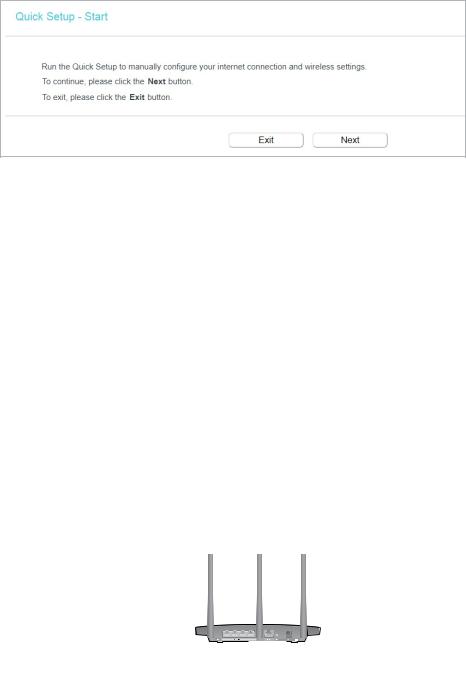
Chapter 4 |
Configure the Router |
2. Go to Quick Setup.
3.Click Next to start. Then follow the step-by-step instructions to connect your router to the internet.
4.3. Operation Mode
The router supports two operation modes: Wireless Router mode and Access Point mode.
4. 3. 1. Wireless Router Mode
The default Wireless Router mode is required most commonly. In this mode, the device enables multiple users to share the internet connection via ADSL/Cable Modem.
For hardware connection, refer to Connect Your Router.
4. 3. 2. Access Point Mode
In this mode, this device can be connected to a wired network and transform the wired access into wireless one. If you already have a wired router, you can use this mode.
Internet |
Ethernet1 |
Ethernet2 |
|
|
Wired Router |
Router |
Devices |
1.Find the Internet port on the router, and connect it to the Ethernet port (LAN port) of your existing wired router. Then connect the power adapter and turn on the router.
2.Connect your computer to the router. For details, refer to Connect Your Router.
3.Visit http://tplinkwifi.net, and log in with the username and password you set for the router.
4.Go to Operation Mode.
15
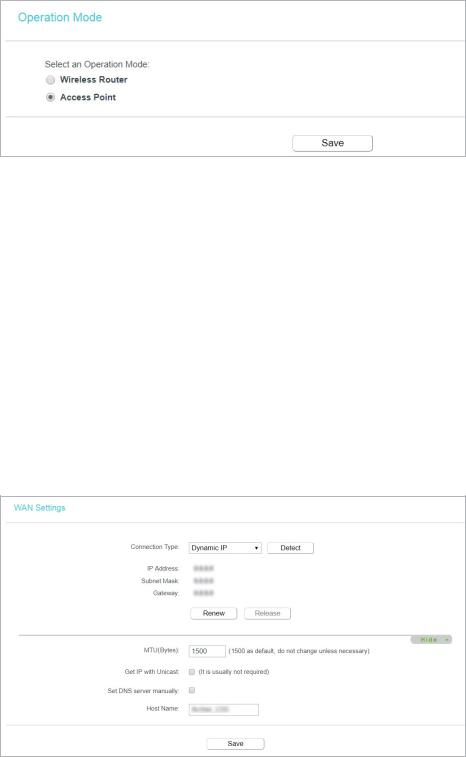
Chapter 4 |
Configure the Router |
5. Select the Access Point mode and click Save.
4. 4. Network
4. 4. 1. WAN
1.Visit http://tplinkwifi.net, and log in with the username and password you set for the router.
2.Go to Network > WAN.
3.Configure the IP parameters of the LAN and click Save.
Dynamic IP
If your ISP provides the DHCP service, please select Dynamic IP, and the router will automatically get IP parameters from your ISP.
Click Renew to renew the IP parameters from your ISP. Click Release to release the IP parameters.
•MTU Size - The normal MTU (Maximum Transmission Unit) value for most Ethernet networks is 1500 Bytes. It is not recommended that you change the default MTU size unless required by your ISP.
16
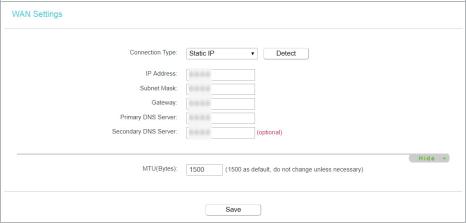
Chapter 4 |
Configure the Router |
•Get IP with Unicast - A few ISPs’ DHCP servers do not support the broadcast applications. If you cannot get the IP address normally, you can choose this option. (It is rarely required.)
•Set DNS server manually - If your ISP gives you one or two DNS addresses, select Set DNS server manually and enter the primary and secondary addresses into the correct fields. Otherwise, the DNS servers will be assigned automatically from your ISP.
•Host Name - This option specifies the name of the router.
Static IP
If your ISP provides a static or fixed IP address, subnet mask, default gateway and DNS setting, please select Static IP.
•IP Address - Enter the IP address in dotted-decimal notation provided by your ISP.
•Subnet Mask - Enter the subnet mask in dotted-decimal notation provided by your ISP. Normally 255.255.255.0 is used as the subnet mask.
•Gateway - Enter the gateway IP address in dotted-decimal notation provided by your ISP.
•Primary/Secondary DNS Server - (Optional) Enter one or two DNS addresses in dotted-decimal notation provided by your ISP.
•MTU (Bytes) - The normal MTU (Maximum Transmission Unit) value for most Ethernet networks is 1500 Bytes. It is not recommended that you change the default MTU size unless required by your ISP.
PPPoE
If your ISP provides PPPoE connection, select PPPoE.
17

Chapter 4 |
Configure the Router |
||
|
|
|
|
|
|
|
|
•PPP Username/Password - Enter the user name and password provided by your ISP. These fields are case-sensitive.
•Confirm Password - Enter the password provided by your ISP again to ensure the password you entered is correct.
•Secondary Connection - It’s available only for PPPoE connection. If your ISP provides an extra connection type, select Dynamic IP or Static IP to activate the secondary connection.
•Connection Mode
•Always On - In this mode, the internet connection will be active all the time.
•Connect on Demand - In this mode, the internet connection can be terminated automatically after a specified inactivity period (Max Idle Time) and be reestablished when you attempt to access the internet again. If you want to keep your internet connection active all the time, please enter 0 in the Max Idle Time field. Otherwise, enter the number of minutes you want to have elapsed before your internet access disconnects.
•Connect Manually - You can click Connect/Disconnect to connect/disconnect immediately. This mode also supports the Max Idle Time function as Connect on Demand mode. The internet connection can be disconnected automatically after a specified inactivity period (Max Idle Time) and not be able to re-establish when you attempt to access the internet again.
•Authentication Type - Choose an authentication type.
 Note:
Note:
• Sometimes the connection cannot be terminated although you have specified the Max Idle Time because some applications are visiting the internet continually in the background.
If you want to do some advanced configurations, please click Advanced.
18
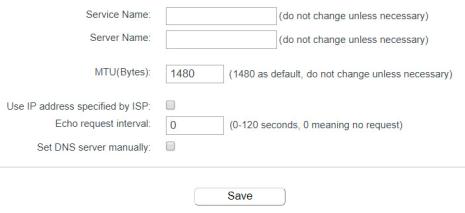
Chapter 4 |
Configure the Router |
||
|
|
|
|
|
|
|
|
•Service Name/Server Name - The service name and server name should not be configured unless you are sure it is necessary for your ISP. In most cases, leaving these fields blank will work.
•MTU (Bytes) - The default MTU size is 1480 bytes. It is not recommended that you change the default MTU size unless required by your ISP.
•Use IP address specified by ISP - If your ISP does not automatically assign IP addresses to the router, select this and enter the IP address provided by your ISP in dotted-decimal notation.
•Echo request interval - The router will detect Access Concentrator online at every interval. The default value is 0. You can input the value between 0 and 120. The value 0 means no detect.
•Set DNS server manually - If your ISP does not automatically assign DNS addresses to the router, select this and enter the IP address in dotted-decimal notation of your ISP’s primary DNS server. If a secondary DNS server address is available, enter it as well.
L2TP
If your ISP provides L2TP connection, please select L2TP.
19
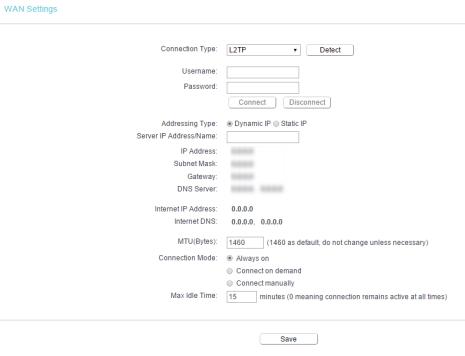
Chapter 4 |
Configure the Router |
||
|
|
|
|
|
|
|
|
•Username/Password - Enter the user name and password provided by your ISP. These fields are case-sensitive.
•Addressing Type - Choose the addressing type given by your ISP, either Dynamic IP or Static IP. Click the Connect button to connect immediately. Click the Disconnect button to disconnect immediately.
•Server IP Address/Name - Enter server IP address or domain name provided by your ISP.
•MTU(Bytes) - The default MTU size is “1460” bytes, which is usually fine. It is not recommended that you change the default MTU Size unless required by your ISP.
•Connection Mode
•Always On - In this mode, the internet connection will be active all the time.
•Connect on Demand - In this mode, the internet connection can be terminated automatically after a specified inactivity period (Max Idle Time) and be reestablished when you attempt to access the internet again. If you want to keep your internet connection active all the time, please enter 0 in the Max Idle Time field. Otherwise, enter the number of minutes you want to have elapsed before your internet access disconnects.
•Connect Manually - You can click Connect/Disconnect to connect/disconnect immediately. This mode also supports the Max Idle Time function as Connect on Demand mode. The internet connection can be disconnected automatically after a specified inactivity period (Max Idle Time) and not be able to re-establish when you attempt to access the internet again.
20

Chapter 4 |
Configure the Router |
 Note:
Note:
Sometimes the connection cannot be terminated although you have specified the Max Idle Time because some applications are visiting the internet continually in the background.
PPTP
If your ISP provides PPTP connection, please select PPTP.
•Username/Password - Enter the user name and password provided by your ISP. These fields are case-sensitive.
•Addressing Type - Choose the addressing type given by your ISP, either Dynamic IP or Static IP. Click the Connect button to connect immediately. Click the Disconnect button to disconnect immediately.
•Server IP Address/Name - Enter server IP address or domain name provided by your ISP.
•MTU(Bytes) - The default MTU size is “1460” bytes, which is usually fine. It is not recommended that you change the default MTU Size unless required by your ISP.
•Connection Mode
•Always On - In this mode, the internet connection will be active all the time.
•Connect on Demand - In this mode, the internet connection can be terminated automatically after a specified inactivity period (Max Idle Time) and be reestablished when you attempt to access the internet again. If you want to keep your internet connection active all the time, please enter 0 in the Max Idle Time field. Otherwise, enter the number of minutes you want to have elapsed before your internet access disconnects.
21
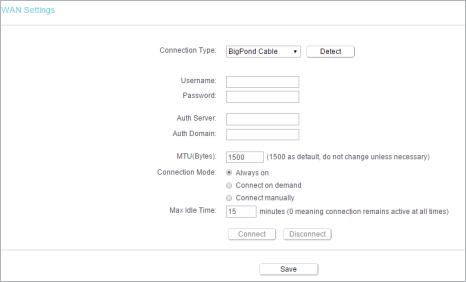
Chapter 4 |
Configure the Router |
•Connect Manually - You can click Connect/Disconnect to connect/disconnect immediately. This mode also supports the Max Idle Time function as Connect on Demand mode. The internet connection can be disconnected automatically after a specified inactivity period (Max Idle Time) and not be able to re-establish when you attempt to access the internet again.
 Note:
Note:
Sometimes the connection cannot be terminated although you have specified the Max Idle Time because some applications are visiting the internet continually in the background.
BigPond Cable
If your ISP provides BigPond cable connection, please select BigPond Cable.
•Username/Password - Enter the user name and password provided by your ISP. These fields are case-sensitive.
•Auth Server - Enter the authenticating server IP address or host name.
•Auth Domain - Type in the domain suffix server name based on your location.
•MTU(Bytes) - The default MTU size is 1480 bytes. It is not recommended that you change the default MTU size unless required by your ISP.
•Connection Mode
•Always On - In this mode, the internet connection will be active all the time.
•Connect on Demand - In this mode, the internet connection can be terminated automatically after a specified inactivity period (Max Idle Time) and be reestablished when you attempt to access the internet again. If you want to keep your internet connection active all the time, please enter 0 in the Max Idle Time field. Otherwise, enter the number of minutes you want to have elapsed before your internet access disconnects.
•Connect Manually - You can click Connect/Disconnect to connect/disconnect immediately. This mode also supports the Max Idle Time function as Connect
22
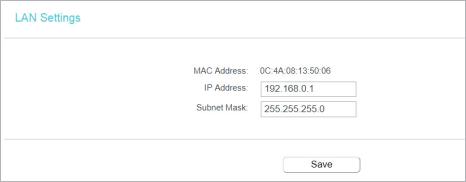
Chapter 4 |
Configure the Router |
on Demand mode. The internet connection can be disconnected automatically after a specified inactivity period (Max Idle Time) and not be able to re-establish when you attempt to access the internet again.
4. 4. 2. LAN
1.Visit http://tplinkwifi.net, and log in with the username and password you set for the router.
2.Go to Network > LAN.
3.Configure the IP parameters of the LAN and click Save.
•MAC Address - The physical address of the LAN ports. The value can not be changed.
•IP Address - Enter the IP address in dotted-decimal notation of your router.
•Subnet Mask - An address code that determines the size of the network. Normally 255.255.255.0 is used as the subnet mask.
 Note:
Note:
• If you have changed the IP address, you must use the new IP address to log in.
• If the new IP address you set is not in the same subnet as the old one, the IP address pool in the DHCP Server will be configured automatically, but the Virtual Server and DMZ Host will not take effect until they are re-configured.
4. 4. 3. IPTV
1.Visit http://tplinkwifi.net, and log in with the username and password you set for the router.
2.Go to Network > IPTV.
3.Configure IPTV settings and click Save.
23
